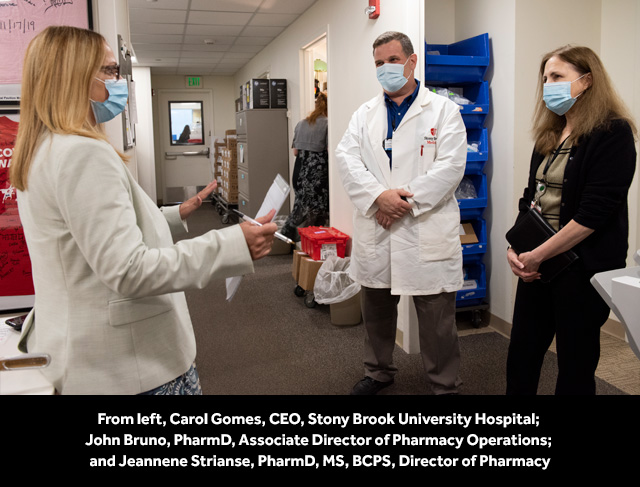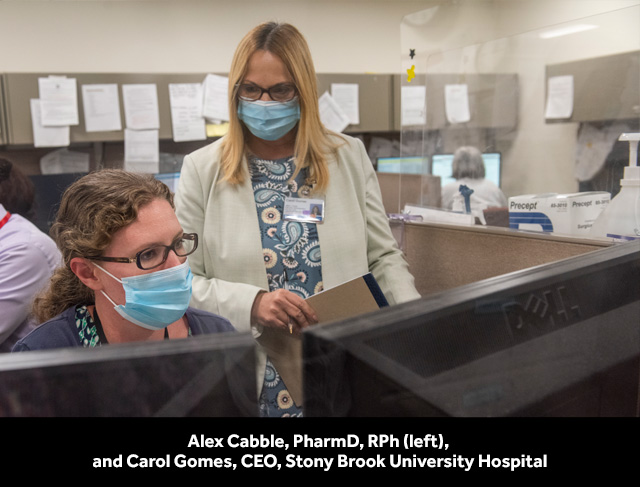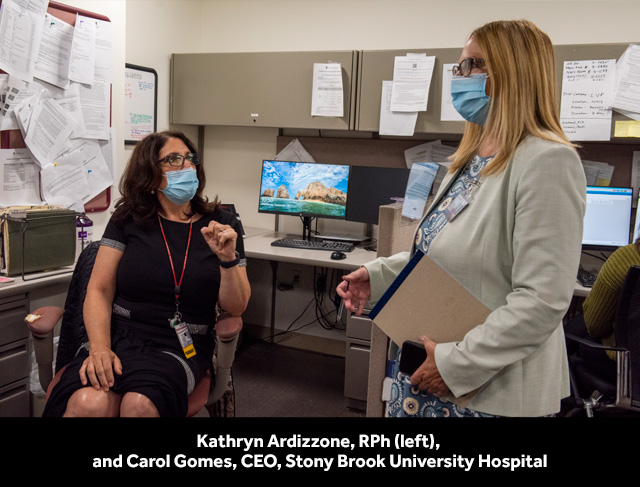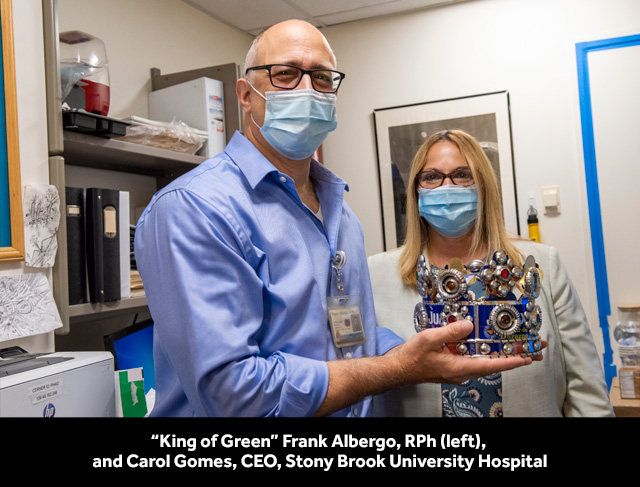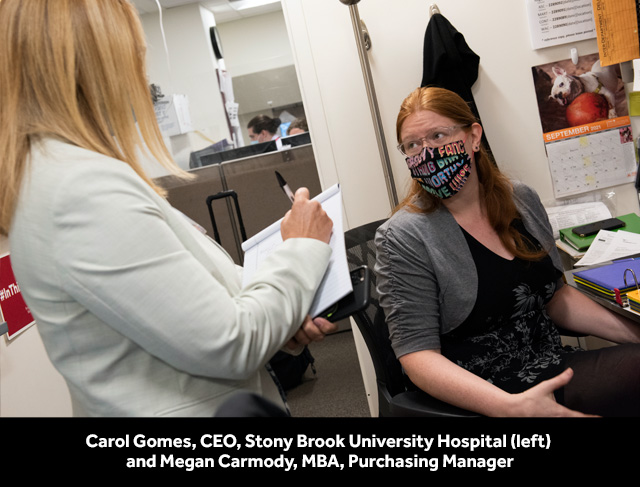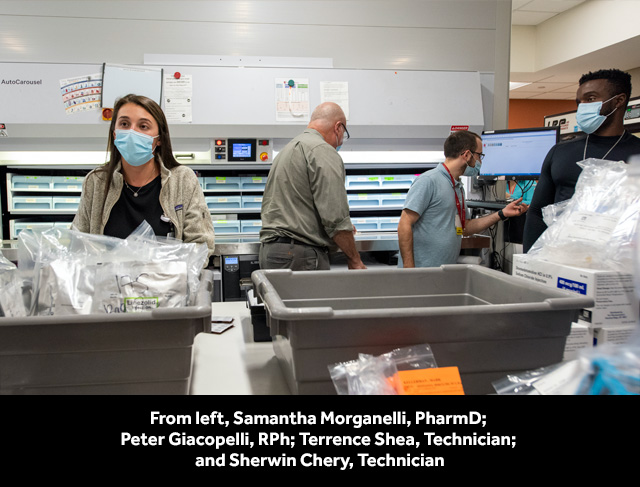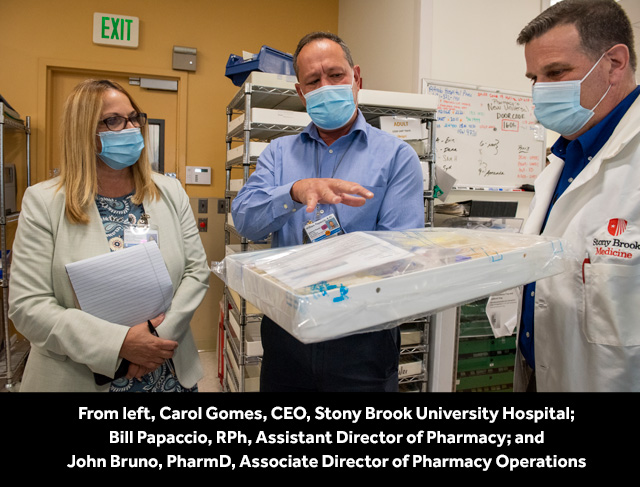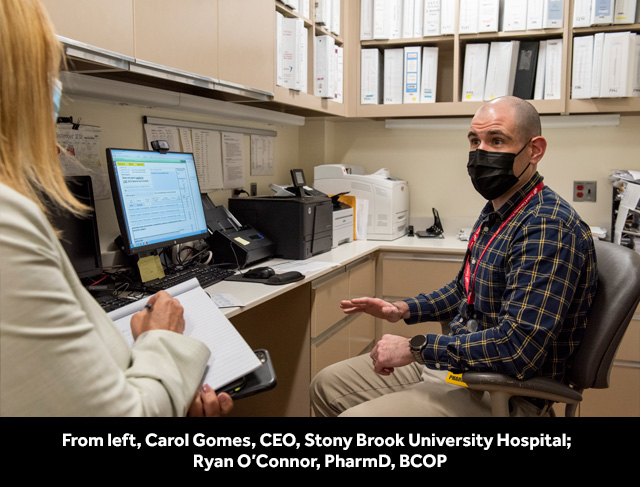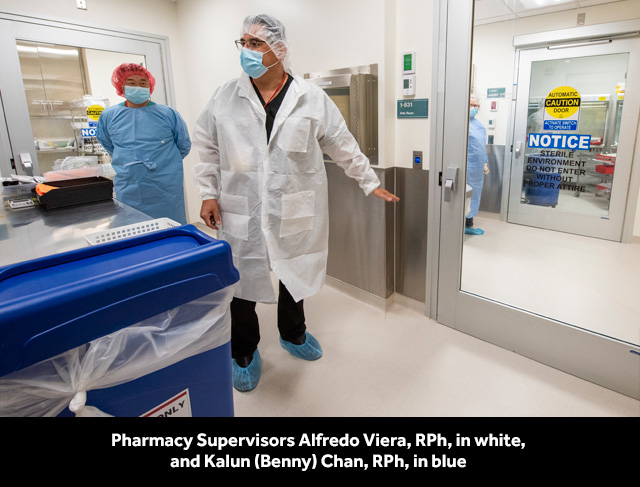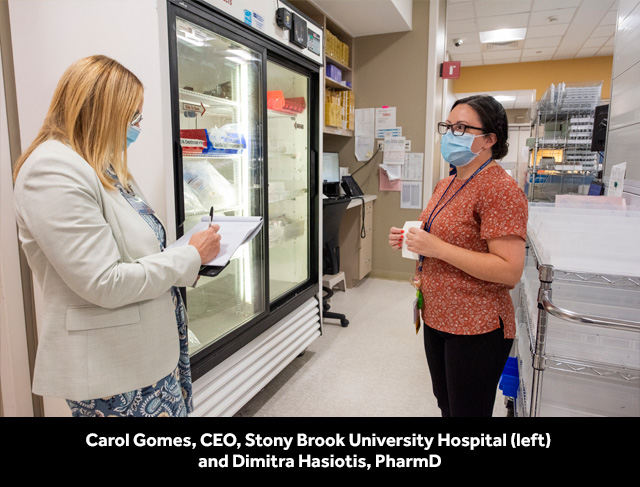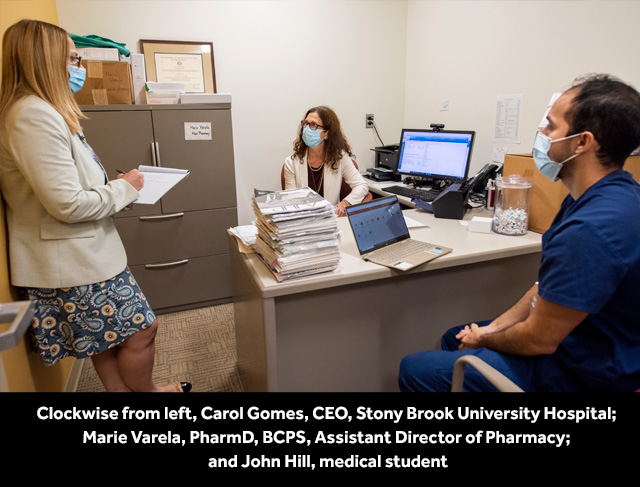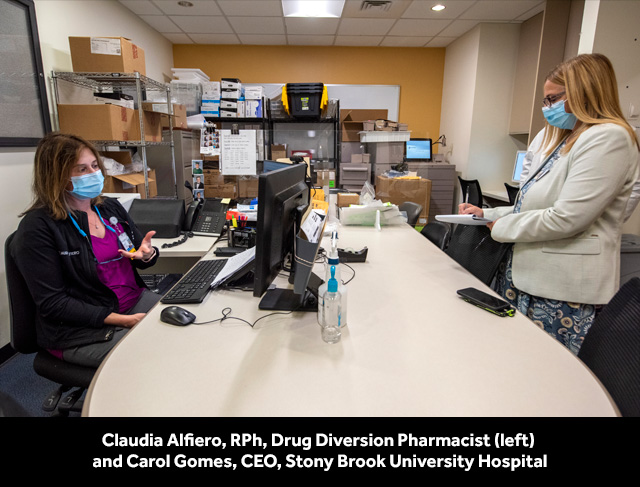Alex Cabble, PharmD, shared the workflow she uses to verify orders while checking for allergies and contraindications to medications to ensure safe patient care. She proudly described how her father, also a pharmacist, inspired her to pursue a career in healthcare. After exploring potential options, including nursing and physical therapy, she decided to pursue an educational focus on pharmacy, with a particular emphasis on addressing zero patient harm as part of our journey to become a high-reliability organization. Alex completed her pharmacy residency at Stony Brook in 2014 and is currently our solid organ transplant pharmacist.
Kathryn Ardizzone, RPh, has worked at Stony Brook University Hospital for 33 years, and is one of the department’s longest serving pharmacists. When asked about the key to her success, she stated that she feels a sense of community and has fun along the way.
And speaking of fun, I also had an opportunity to converse with Frank Albergo, RPh, otherwise known as the official “King of Green” for his efforts associated with sustainability initiatives in the Pharmacy. As he donned his recycled crown, he shared important aspects of his role within the Pharmacy Department that address information technology use to manage Cerner/Pharmnet activities. This important work involves managing the health system’s formulary, integrating with Craneware to monitor revenue cycle activities, and hardwiring computerized physician order entry (CPOE) rules and alerts when necessary, while actively reducing unnecessary alerts. More recently, as Stony Brook continues to improve its ranking with Leapfrog, Frank works with the Information Technology and Quality teams to incorporate the necessary components for success.
In order to ensure adequate stocking of the necessary medications to care for all of our inpatients, Megan Carmody, MBA, works hard to procure goods and services by coordinating contracts and managing millions of dollars of pharmaceuticals.
Mandy Gillam, RPh, has worked in the world of pharmaceuticals for 19 years. She has had several experiences along the way, working as a pharmaceutical sales representative, and also working at Mount Sinai in Manhattan. She enjoys her role at Stony Brook University Hospital, because she feels like she makes a difference in patients’ lives. She stated, “the better we are, they better they (the patients) are.”
Samantha Morganelli, PharmD, is a newcomer to Stony Brook University Hospital. She has been working here for one year and genuinely enjoys working with the team. Samantha interacts regularly with nurses and physicians on the floors and makes connections with those within and outside of the pharmacy walls. Samantha also appreciates the support she has received as a relatively new staff member, as the philosophy in the department is that questions are welcomed.
Peter Giacopelli, RPh, has been with Stony Brook for more than 15 years. He appreciates the comradery “from administration to all other levels in the organization.” Peter mentioned that he is amazed at the professionalism exhibited by our team members every day along with the positive interactions that result in excellent patient care. Peter described the process by which medications are obtained, including the process for organizing medications for Pyxis machine stocking on the units.
Bill Papaccio, RPh, Assistant Director of Pharmacy, described the use of carousels in the department, where drugs are stored, and how par levels are monitored to ensure adequate supplies are on hand for patient use. He and John Bruno, PharmD, Associate Director of Pharmacy Operations, further described the use of barcoding medications in order to ensure that the right patient is administered the right drug with the right route and dose.
As we discussed pharmaceutical research activities, Ryan O’Connor, PharmD, was able to provide the lay of the land. Most recently, Pfizer clinical trials relating to pediatric COVID-19 vaccinations (ages 5 to 12) are being closely investigated and have led to changes in clinical practice. The team working with investigational drugs coordinates paperwork, ensures that sponsor documentation is acceptable and works closely with the investigators to make sure a sound plan for each study is addressed, from protocols and staffing to IRB approvals. Currently, there are more than 130 active multi-year studies underway, and COVID-19 activity has contributed to a bump up of even more studies.
The new sterile compounding room is a sight to behold. This new room allows the organization to comply with new pharmaceutical guidelines to create an ISO-rated USP 797 space, which is the envy of many hospital pharmacy departments. Benny Chan, RPh, shared the protocols for properly using the new space to ensure eliminating potential contamination and sharing the IV workflows and the multiple hoods in place to provide an optimal environment for the work produced in this area within the Pharmacy. With 23 years of experience at Stony Brook, he expressed his appreciation for the nurses and physicians with whom he interacts on a daily basis.
Balancing Benny’s experience, Dimitra Hasiotis, PharmD, a recent Stony Brook University graduate, has been working in the Pharmacy for only eight months. Her experience at Stony Brook has been positive, as she states that she finds it interesting to continually learn while working at an academic medical center, constantly honing clinical knowledge while experiencing stellar internal communication among the team.
Medication safety is clearly an important goal for all of us. Thankfully, Marie Varela, PharmD, with more than 30 years of experience, brings her expertise and talent to the table by reviewing medication-related opportunities for improvement through analysis of SB Safe data. Besides addressing medication safety processes, she also oversees the decentralization of various high-risk pharmacy activities in several intensive care units, the Emergency Department, with patient transfers and other areas of focused activity.
Claudia Alfiero, RPh, a controlled drug pharmacist and drug diversion specialist, started at the hospital in 1992, and in 2016, she took on a role to focus on drug diversion processes. Claudia values her role as she enjoys helping people and believes that her contributions are valuable to the organization.
It was an incredible experience interacting with the team in our Pharmacy Department. Thanks to the leadership of the department, including Jeannene Strianse, PharmD, Director of Pharmacy, and Laurie Rafkin, Senior Associate Director of Operations. Functions in Pharmacy have grown considerably over many years. Pharmacists are at the forefront to coordinate and vaccinate. Pharmacists participate in rounds on units, using their expertise to ensure that we are prudent in our medication choices in terms of safety, efficacy and cost. And finally, pharmacists contribute positively in the care of our patients as virtually every patient in the hospital receives one or more medications during their stay. No doubt, pharmacists are vital to the success of ensuring safe patient care. It was an honor and privilege to experience pharmacist functions through the eyes of our very own team at Stony Brook Medicine.
Carol


